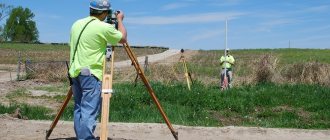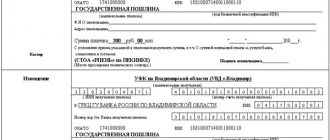The status of a land plot determines the legality of land exploitation. Displays the intended purpose of the plot, the form of permitted use, and the method of ownership. The cadastral passport already states the status of the land, and you can familiarize yourself with it when choosing a land plot for purchase or completing certain documents.
Types of statuses
After the registration data about the real estate property is filled in, the status “Entered” is determined in the Unified State Register. Subsequently, depending on the stage of registration of certificates and rights to the site, the procedure for submitting mandatory information to the appropriate authority and other information, the status of the land may be as follows:
- Temporary. Information about the site has been transferred to the state register department, but the registration procedure has not yet been brought to its logical conclusion of the current process. If cadastral work has not yet been carried out, the land will have the status - Temporary.
- Canceled. Property rights have not been registered for 5 years.
- Accounted for and previously accounted for. Status previously taken into account - information about the owner was not provided in full, territorial boundaries were not established. Accounted – information about the owner or temporary owner has been entered in full.
What does the status of a land plot mean – Archive? It is assigned to an object if the entries in the Unified State Register are not relevant for the current period of time, or the plot has been removed from the cadastral register.
What does status mean - current?
When collecting documents by EGRN employees from the State Property Committee and the Unified State Register, the information about the land plot must match. And if so, the status is assigned - Current. Otherwise, it will sound like this - Actual unattested.
In what cases does this happen:
- If reconstruction, redevelopment or other work was carried out, as a result of which the total area was changed.
- The trial is ongoing and a final verdict has not yet been made. That is, current information is not relevant, and new data is not yet known.
- Change of address and category of allotment. Only government agencies have this right. They can make changes without prior notice to the cadastral chamber.
So we figured out what the status of a land plot means – Current.
Dispute No. 1. Cadastral error in the location of borders
The fundamental basis of any dispute about the boundaries of a land plot is a cadastral error, i.e., a discrepancy between the legal (enshrined in the state real estate cadastre) and the actual (actually existing on the ground) boundaries of the land plot. A cadastral error entails certain difficulties in using a land plot. Such a mistake can be made by a cadastral engineer, authorities who incorrectly prepared a site layout diagram, or a court when making a decision.
If there is a discrepancy between the information entered in the real estate cadastre and the actual characteristics of the land plot, then the owners of premises in the apartment building have the right to demand correction of the error out of court.
An out-of-court procedure is possible in the absence of disputes between the applicants, owners of neighboring plots and the Rosreestr body, or if these disputes are resolved before trial. The Unified State Register of Real Estate (USRN) contains information about the existence of a land dispute about the location of the boundaries of a land plot, up to their clarification (Article 43 of the Federal Law of July 13, 2015 No. 218-FZ, hereinafter referred to as Law No. 218-FZ).
If it was not possible to resolve disagreements regarding the boundaries of the land plot, then the owners of the premises in the apartment building or their authorized representative have the right to file an application with the court to establish the location of the boundaries of the land plot. The defendant in the case will be the owner of the adjacent land plot, Rosreestr will act as a third party.
To determine the correct location of the boundaries of the disputed land plot, the court must request a boundary plan of the site, and, if necessary, other land management documentation. The court may order a land management examination (Article 79 of the Code of Civil Procedure of the Russian Federation). In this case, the expert will be asked questions about the compliance of the legal and actual boundaries of the land plot; about the magnitude and nature of deviations of actually established boundaries and other equally important issues.
The court should pay special attention to those objects (natural or artificial, existing in the area for 15 years or more), on the basis of which the location of the boundaries of the land plot was determined. These can be trees, fences, poles, etc. Such information is very important, since in the absence of documentary evidence of the boundaries of a land plot, its location is determined by the named objects (clause 10 of article 22 of Law No. 218-FZ).
After the court decision has entered into legal force, you should contact Rosreestr with an application to register the land plot with cadastral registration or to carry out cadastral registration in connection with clarifying the location of the boundaries of the land plot based on the court decision.
How can I find out the status of a land plot?
To find out this information, it is not at all necessary to personally contact the authorized body; it is enough to go to the official website of the Rosreestr. Here you can find all the data on land that is included in the State Property Committee.
In particular, the following information is reflected:
- Territorial boundaries.
- Cadastral information.
- Category of the site and its intended purpose.
- Cadastral value of the property, total area, form of ownership and other legal information.
If you plan to purchase a plot of land, all these nuances should be studied so that no problems arise in the future. If desired, you can use the services of a competent lawyer.
Use of land other than for its intended purpose is an undeniable basis for seizure from the owner. This also applies to those cases when residential buildings are built in areas not intended for these purposes.
Conducting land surveying under an apartment building
- In the first case, a plot is drawn up along the contour of the house and, possibly, a small plot that is needed for servicing the house.
- In the second case, the surrounding area is decorated with all the sites and, if the situation allows, even a little more (for example, if there is empty land behind the house that residents want to designate as parking spaces).
To form a plot within the boundaries, it is necessary to carry out cadastral work on it (Federal Law No. 221). In new buildings, this responsibility falls on the developers, since without land surveying they will not be able to deliver the property. In old buildings, land surveying is carried out on the initiative of the owners of the apartment building.
Interesting: Water Tariffs in Moscow from July 1, 2020
What does status affect?
Separately, it is worth noting some specific nuances that can directly affect the exploitation of land:
- If you plan to build a residential building on an agricultural territory, you will first need to change the type of permitted use in accordance with the law.
- The plot is less than 4 acres, and the citizen intends to build a house or other residential premises on it. Initially, you will need to obtain permission from local governments. That is, in the local administration of the settlement (city).
- Specially protected areas include coastal zones of water bodies. The minimum distance from the shore to the house is 20 meters. The main condition is that there should be no fences, not even decorative ones.
- On agricultural lands, the construction of a country house is permitted, without permanent residence in it. You can also build utility rooms; there are no restrictions on their number.
The legal status of the land plot “Temporary” indicates that it is in state ownership. It can be transferred for the construction of communication and transport systems. The status can be changed by registering property rights or taking the land for lease use. This option is possible if the owner is the state or municipality.
What do you need to know about the local area?
The adjacent territory is determined at the planning stage of a future multi-apartment building, established on the basis of a technical or cadastral passport (now abolished, all information is entered into the Unified State Register).
Reducing the allocated area is prohibited, including by government agencies. Selling is the same, but renting out or changing the purpose of using a particular area is allowed (for example, to remove garages and build a new playground in their place).
How to determine the local area of an apartment building?
The clear boundaries of the local area of an apartment building are described in the cadastral passport; this information is stored in the Unified State Register of Real Estate. An extract from this register can be obtained by every owner of an apartment located in the building to which the territory is assigned.
The determination of the local area is carried out at the stage of drawing up the construction plan by allocating land for construction needs; it is the developer who receives the first copy of the documents, the data from which is entered into the Unified State Register of Real Estate.
What size should this area be? The order of the Ministry of Construction, Land and Property Relations (from 1998) specifies a clear formula according to which the minimum area of the adjacent territory of an apartment building must be no less than the area of all apartments in the building itself (excluding flights of stairs, premises for ensuring the work of engineering communications).
The so-called “share coefficient per square meter” is also added to it, which cannot be less than 1. This figure includes the entire territory that the owners of the house can dispose of at their own discretion (within legal limits).
Where can I find out the boundaries of the local area of an apartment building?
This information is indicated in the extract from the Unified State Register of Real Estate with a detailed plan.
You can get it in the following ways:
- By submitting a request to Rosreestr (this can only be done by the owner of one of the apartments or a person legally residing in such real estate, for example, on a rental basis);
- By submitting a request to the MFC (also carried out only by the owner).
By the way, now a request can be submitted to Rosreestr remotely, in electronic form; you do not need to personally visit the organization’s representative office. Previously, it was necessary to contact the cadastral chambers to obtain information, but starting from 2020 they have been abolished.
In the extract, in addition to indicating the size of the occupied area, there must be a conventional drawing with dimensions, according to which you can set the boundary for the local area.
Information about the border is indicated in the extract from the Unified State Register of Real Estate with a detailed plan.
What share is each apartment owner entitled to? It is equivalent to the area it occupies multiplied by the “fraction factor per square meter”. You can even clearly limit your own territory, but only if representatives of the management company (or the residents themselves, if OSBB is used) give permission.
Clarification of difficult points
Violation of the type of permitted use of land is a difficult point to determine. In judicial practice there is no general view of such a violation, but the difference between them is huge.
In some courts, the type of permitted use of the plot is considered as compliance with the declared directives. A different approach does not consider changing the VRI as going beyond the intended purpose; accordingly, there can be no talk of legal liability.
There are a lot of contradictions in judicial practice on issues of violation of the intended use of land. Different authorities may make diametrically different decisions on the same issue. Therefore, in order for the court to always be on the side of the owner, legal scholars recommend seeking the services of competent specialists in the field of land law.
What is the difference between a site category and a RVI?
The legislation does not provide a clear interpretation of the permitted type of land use. Therefore, the concept is taken from the existing legislative framework. RVI is a characteristic of an allotment based on the zoning of territorial boundaries with a designated purpose. That is, the permitted type of use determines the functional purpose and status of land plots. For example, for the construction of multi-storey buildings.
The purpose of creating a classification of territories is to preserve the original properties of the land. The concept of “site category” has a fairly broad meaning, and RVI is of a clarifying nature. Let’s take as an example an allotment in a gardening non-profit partnership, and it will have the following characteristic data:
- Category – conducting agricultural activities.
- RVI (what you can do on the site) - plant a garden, vegetable garden.
- Basis - the land is registered as private property or rented by a specific person.
There are 3 types of permissible use of plots - main, conditionally permitted, auxiliary. The last variety is used simultaneously with the first and second types. If the use of the plot is conditionally permitted, consent will be required from the local administration. To do this, mandatory hearings are held, after which a decision will be made.
The main species are determined by the new RVI classifier. It not only streamlined the presentation of information, but also introduced new subtypes. The status of the site may be as follows: construction of garages, low-rise apartment development, higher educational institutions of various specialized levels. In addition, land is provided for equipment of meteorological services, construction of schools and kindergartens.









